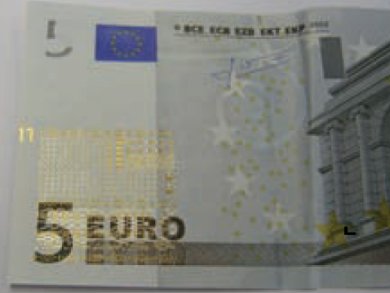Modern banknotes include up to 50 different anti-counterfeiting features, including watermarks, holograms, raised printing, embedded foil strips, and fluorescent inks. The integration of silicon circuits has been consider as an active method of preventing counterfeiting, but current silicon chips (ca. 20 μm) are too thick to be incorporated into banknotes.
Ute Zschieschang and colleagues, Max Planck Institute for Solid State Research, Stuttgart, Germany, have developed organic thin-film transistors (TFTs) which can be fabricated directly on the surface of banknotes. The team adapted the fabrication process of TFTs on glass to include an all-dry method of formation of the alkylphosphonic acid self-assembled monolayer onto which the TFTs are deposited. The TFTs consisted of two organic semiconductors — dinaphtho[2,3-b:2′,3′-f]thieno[3,2-b]thiophene and hexadecafluorocopperphthalocyanine.
The transistors and circuits have a thickness of less than 250 nm and can be operated with voltages of about 3 V, making them promising candidates for incorporation into banknotes without damaging them.
Image: (c) Wiley-VCH
- Organic Electronics on Banknotes
U. Zschieschang, T. Yamamoto, K. Takimiya, H. Kuwabara, M. Ikeda, T. Sekitani, T. Someya, H. Klauk
Adv. Mat. 2010.
DOI: 10.1002/adma.201003374




